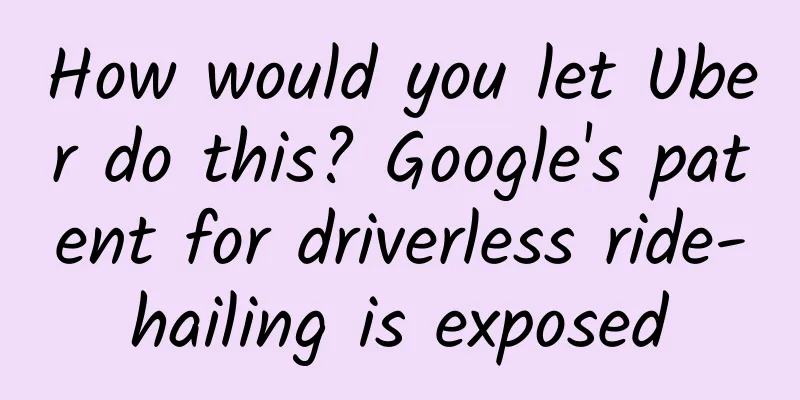How would you let Uber do this? Google's patent for driverless ride-hailing is exposed

|
A lot of big news comes from patents. From 2009 to now, Google's driverless car project has been going on for 8 years. After eight years of technology accumulation, the project was recently separated into a company called Waymo, which officially began to promote the commercialization process. Currently, Google has cooperated with Chrysler to build 100 Pacifica self-driving cars, and has also announced a cooperation with Honda. However, all cars equipped with Waymo's self-driving technology are currently used for testing rather than providing services to ordinary users. In other words, it is still at the technical stage. What about commercialization? A patent recently exposed by the media proves that Google has considered the commercialization of driverless cars. The content of this patent is "terrifying" - to a large extent, Google wants to use driverless cars to "disrupt" Uber and Didi. After all, the most typical scenario for putting driverless cars into commercial operation is car sharing. Therefore, Google cannot only provide perception and decision-making technologies, but also needs to handle operation/dispatching. This patent of Google is to solve the problem of "how driverless cars pick up passengers". It is not difficult to understand: when you take a Didi/Uber, even a human driver may not be able to find you, let alone a driverless car. So the question is: human drivers know how to look at the map and go to the destination, but how can a driverless car do it? From the information in the patent, we can roughly understand Google's logic for solving the problem of driverless cars picking up passengers. Like Didi/Uber, users call a car through a mobile app, the phone location is the departure point, and the destination needs to be manually entered by the passenger. However, for driverless cars, due to safety and technical reasons, not all locations are suitable for picking up and dropping off passengers or waiting for people. For example, self-driving cars cannot drive everywhere like human drivers, after all, computers are not as flexible and smart as human brains. In addition, places such as construction sites, fire station entrances, and expressways are not allowed to stop and wait for people. (Human drivers know this at a glance, but self-driving cars don’t know, and someone needs to tell them…) Therefore, Google recommends pick-up points near your location when you call a car. For the location recommendation mechanism of Google's driverless car dispatch system, you can see the figure below, where the black box/circle is the range demarcated according to the location, and the black dot represents the place where you can park: Some of the recommended parking spots come from user recommendations, and some come from Google Maps. In the entire unmanned vehicle dispatch system, Google's high-precision maps play an important role, providing roads, buildings, fire hydrants, construction sites and real-time traffic information. This information comes from many sources, including government agencies, Google's partners, user feedback, and road information collected by unmanned vehicles. Of course, this requires a cloud to handle the needs of all people and vehicles. In this patent, Google gave the prototype of the driverless car mobile app: When there are no available parking spots around you, you cannot call a driverless car, such as in this scenario: In fact, the "recommended pick-up point" design is widely used in Uber and Lyft. For example, in Las Vegas, if you call a car at a hotel, the system will ask you to wait for the car at a certain gate, and if you call a car near the CES venue, the system will also "guide" you to the parking lot - a temporary pick-up point for special cars. Of course, domestic special car apps also have this design in certain specific scenarios. The pick-up location design may seem like a very detailed issue, but Google has already thought of it and applied for a patent. Even if this does not mean that they want to make a driverless version of Uber, it does indicate to some extent Google’s ideas for the commercialization of driverless cars. Waymo is actually a good friend of car companies, but it wants to revolutionize Uber and Lyft. Autonomous driving will have a revolutionary impact on shared cars represented by private cars, and private car platforms represented by Uber are of course aware of this. Therefore, Uber has also made arrangements for driverless driving early (of course not as early as Google...). A while ago, they also tested the self-driving car based on Volvo XC90 in Pittsburgh in California, and it ran a red light, and was immediately stopped by the California government. As for Lyft, some media reported that they and GM started testing self-driving cars in 2017, and integrated the technology of Cruise (an autonomous driving startup acquired by GM). Maybe when they encounter the problem of driverless pickup in the future, they will find that Google has already applied for a patent, and they will either spend money to buy it or find a way to circumvent this patent. But for now, everyone is still loving each other. For example, thanks to the recent cooperation between Google and Uber, you can directly call an Uber after searching for a point of interest in the Google Maps app without leaving the app. But who can say for sure whether there will be a battle between Google, Uber, Lyft and even Didi in the field of driverless car sharing in the future? As a winner of Toutiao's Qingyun Plan and Baijiahao's Bai+ Plan, the 2019 Baidu Digital Author of the Year, the Baijiahao's Most Popular Author in the Technology Field, the 2019 Sogou Technology and Culture Author, and the 2021 Baijiahao Quarterly Influential Creator, he has won many awards, including the 2013 Sohu Best Industry Media Person, the 2015 China New Media Entrepreneurship Competition Beijing Third Place, the 2015 Guangmang Experience Award, the 2015 China New Media Entrepreneurship Competition Finals Third Place, and the 2018 Baidu Dynamic Annual Powerful Celebrity. |
<<: What are the risks of LeTV's stock market after its resumption of trading?
>>: Which city in China is the best at "Internet+"? Beijing ranks eighth
Recommend
Why are subway seats so slippery? On purpose!
Auditing expert: He Yuanda, Deputy General Manage...
Earth Story: A Brief History of Life
Where do we come from? Where are you? Where to go...
Analysis of advertising in the e-commerce industry in April!
As 618 approaches, a new round of battle for traf...
Soul Product Analysis Report
Lonely souls will attract each other. Different f...
The latest news on the epidemic in Fanchang, Wuhu, Anhui in 2022: When will it end and return to normal?
Recently, new local outbreaks have occurred in man...
Information flow promotion, analysis of 7 excellent case studies and techniques!
For third-party optimizers, who deal with clients...
Which promotional platforms are suitable for Father’s Day marketing ads?
June 16th is Father's Day, and there are stil...
Want to eat medicated food to regulate your body after "Yang Kang"? Huaxi doctors: All the methods are written for you!
Yesterday, [Huaxi Doctors] made it clear about th...
Miaopu Personal Information: Is SEO keyword optimization ineffective? Details cannot be ignored
Now when we are doing SEO optimization, many webs...
Google, Airbnb, Amazon, Didi... all use conversion rate optimization secrets
Defined from an economic perspective, growth refe...
How do UI designers analyze products correctly? Check out this comprehensive introductory guide!
Many people think that product analysis is the jo...
2022 Taobao Express System Course Baidu Cloud Download
2022 Taobao Express System Course 000 Introduction...
How to write a good copy that will not be disliked by users?
Just like posting advertising copy in the circle ...
How much RMB is equivalent to 1 US dollar? Real-time quotes of USD/RMB exchange rate today, July 23, 2020
How much RMB is equivalent to 1 US dollar? Today&...
What are the specific indicators for App operations?
1. Understand the traffic diversion capacity of e...









